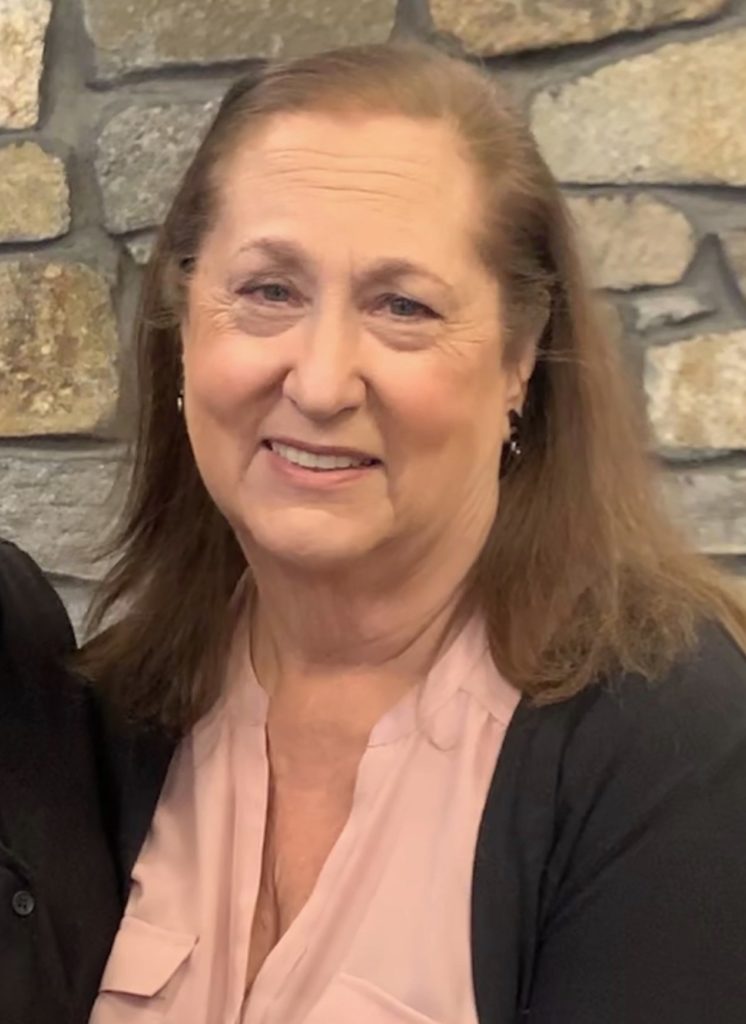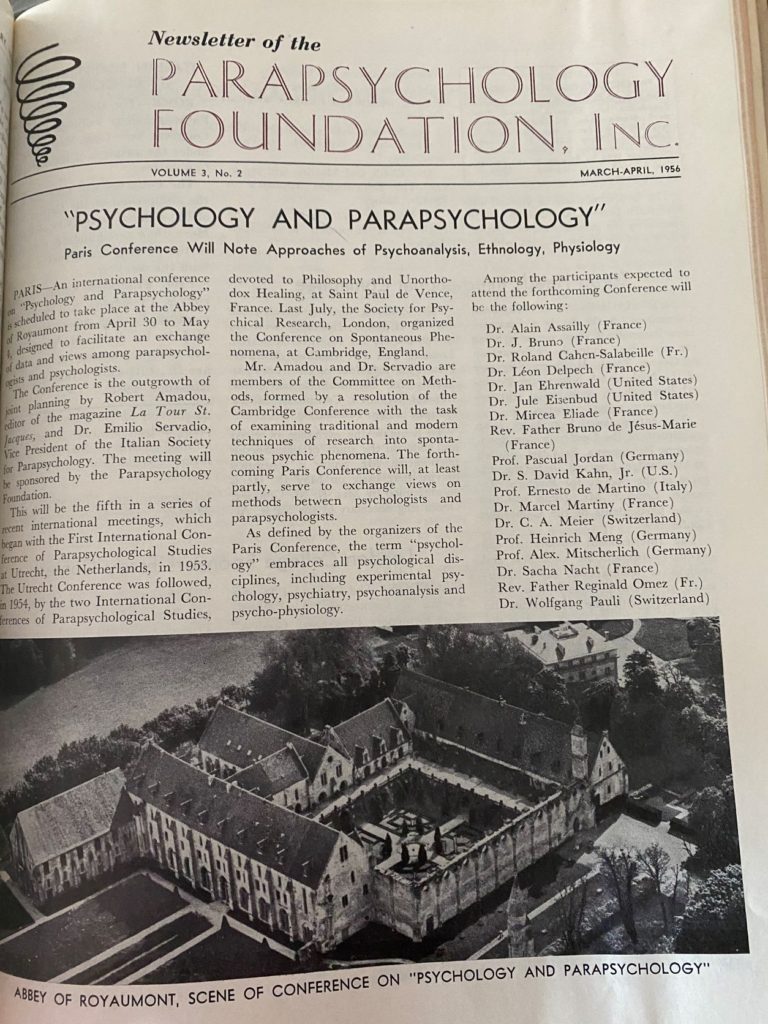
I find myself continually somewhat in disbelief that the PF has been chugging along for now close to 72 years…I admit faster years ago with funding available but continuing to adhere to the vision our co- founders, Eileen J. Garrett and Frances P. Bolton shared with an assist from my mom, Eileen Coly, myself and now my daughter, Anastasia Damalas. Taken from “A Report on Five Years of Activities January 1, 1954-December 31, 1958” I am amazed how prolific a start PF made in making its mark within the science of parapsychology. From time to time I will share with you from this publication these early heady days but for today I want to quote from a summary of a five day symposium on “Psychology and Parapsychology” which took place at the former Abbey of Royaumont, France, from April 30 to May 4, l956 which may be of interest to many of you as it was me.
“The conference implemented one of the resolutions of the PF’s First International Conference of Parapsychological Studies, which had called for several ‘specialized conferences and symposia’ on the relationship between parapsychology and other scientific disciplines.
The Royaumont symposium took place under the joint chairmanship of Mr. Robert Amadou (France) and Dr. Emilio Servadio (Rome). It resolved, at its conclusion, that renewed efforts be made to ‘widen contacts between psychologists, parapsychologists and physicists, with the aim of achieving a better appreciation of possible physiochemical factors that bear upon parapsychological phenomena.’ The meeting expressed its ‘recognition’ of the work done in recent years in the field of ‘psychiatric parapsychology,’ and voiced its ‘confidence that such work will continue in the future.’

The organizers of the symposium declared at the outset of the conference that an exchange of views would be ‘of equal benefit to psychology and parapsychology’ and added: ‘It is not possible to assess fully the impact of parapsychological findings, unless these are placed within the overall framework of scientific hypotheses that constitute modern psychology.’ Mr. Amadou, in an opening address, said that ‘none of our approaches are truly sufficient, and an all-embracing effort is therefore necessary; distinctions between the various scientific disciplines must be regarded as arbitrary, provisional and temporary—the need now is for unification and harmony.’ Dr. Servadio noted that ‘parapsychology now demands increasingly the contributions of other disciplines, in order to fulfill its scientific potential.’
Mr. Amadou, in a paper dealing with ‘Future Study and Research’ offered the following conclusions: ‘(a) Parapsychology has revealed new aspects of certain human experiences and behavior; (b) These new aspects must be considered within the living organism, within their psychological, physiological and cultural context; (c)parapsychology forces us to pose the general problem of man in relation to his biological and social environment; (d) thus progress in parapsychology is bound up with research into the most profound mechanisms of psychosomatic man; ( e ) Two tasks, equally important are necessary, must be fulfilled and are destined to supplement each other reciprocally: First, the comprehensive investigation in all their richness and complexity, of the behavior and experiences in which the irreducible core isolated by parapsychology seems to manifest itself. Second, the elaboration of a hypothesis which, in its most general form (general theory) will stimulate these investigations and which these latter, in turn, will enable us to verify.’
Dr. S. David Kahn, Jr. (USA) spoke on “A Challenge for Scientific Method,’ saying that ‘a painstaking re—examination of our traditional habits of thinking about psi may give rise to genuine innovational habits in experimental design, which will correct our tendency to insist upon psi operating under our conditions rather than under its own.’
Dr. Leon Delpech (France), offering a ‘Preliminary Study of Attitudes,’ dealt with ‘attitudes of those not familiar with the scientific study of parapsychological problems.’ He specifically dealt with ‘resistance to acceptance of evaluated data,’ objections ‘based upon the principle of economy,’ or ‘uncritical evaluation approaching more credulity.’
Dr. Donald J. West (Great Britain) presented the results of a joint study with Mr. G.W. Fisk on ‘Esp and Mood,’ which concluded that subjects ‘most frequently in a pleasurable mood tended to produce the largest positive scores.’
Dr.Emilio Servadio, reviewed ‘The Psychoanalytic Approach to Psi Phenomena,’ stating that ‘we may tentatively assume that precognitive elements can be used in a psychological construction without contradicting any of those schemes which psychoanalysis has adopted—if we put aside causality in the traditional sense and be prepared to enlarge still more our views of analytic transference and counter-transference.’
Dr. Jan Ehrenwald (USA) put forward his concepts of ‘Telepathic Leakage and Doctrinal Compliance.’ He defined ‘telepathic leakage or psi induction’ as ‘ a particular form of telepathy operating between therapist and patient,’ and ‘doctrinal compliance’ as ‘compliance by the patient with the doctrine to which his therapist happens to subscribe.’
Dr. Jule Eisenbud (USA) speaking of ‘Methodological Problems of Psychoanalytic Parapsychology,’ defined as ‘a task of parapsychology’ to ‘lay down and clarify the logical and psychological rules according to which certain selected events are relatable in the absence of any demonstrable connection of physical kind between them.’
Dr. C.A. Meier (Switzerland) dealt with ‘Projection, Transference and Subject-Object Relationship.’ He referred to the relationship between ‘analysand ‘ and ‘analyst’ as ‘a situation of reciprocity’ during which ‘synchronistic events are experienced with some frequency.’ Dr. Meier observed that there are cases of what Prof. C.G. Jung regards as ‘active projection,’ in which the subject ‘seems to catch archetypal contents of the collective unconsciousness by diverting them from the patient to himself through his emotional interest.’
Mr. Pierre Barrucand (France) spoke on ‘Parapsychology and Anthropology,’ taking a critical view of anthropologists who tend to ‘regard parapsychological phenomena unhesitatingly as fraud, quackery or the manifestation of a so-called primitive mind which was regarded as pre-logical, infantile or pathologic.’
Prof. Ernesto de Martino (Italy), speaking on ‘Parapsychology, Ethnology and History of Religion,’ said that increasing collaboration between these three disciplines might help to confirm ‘the cultural relativism which today dominates a large part of ethnology and the history of religion.’
Rev. Reginald-Omez, O.P (France) expressed ‘Views of a Roman Catholic Theologian’ on parapsychology, stating: ‘It is only our present ignorance of certain psychological or organic possibilities of man which provides parapsychology with a provisional object of study which, in fact, remains in the field of conventional psychology. There remain the genuine supernatural phenomena, those which theology designates as miraculous.’
Dr. Alain Assailly (France) reported on ‘Parapsychological Influences of Middle-Aged Persons on Young Sensitives.’ Referring to the observation that ‘adolescents in the throes of puberty play an important part in certain paranormal manifestations’ he cited incidents which would suggest that middle-aged persons, ‘whether consciously or unconsciously,’ are able to exert their influence ‘through the agency of young people.’
Dr. Jean Lhermitte (France ) spoke on ‘Bilocation Phenomena in Neuropathology,’ citing case histories of what are sometimes defined as out-of-the-body experiences in times of physical and emotional stress. He suggested that there were no ground, ‘apart from a few exceptional cases, for connecting this process with a manifestation of supernatural origin.’
Dr. Marcel Martiny (France) defined ‘Different Planes of the Unconscious,’ through which parapsychological phenomena may ‘thrust themselves into the conscious mind of an individual’ or several persons. He stated that ‘this forcible entry is probably effected by three paths—leading from the infra-conscious, the para-conscious and the supra-conscious.’
Mr. Jean Bruno (France) speaking on ‘Yoga and Experimental Psychology,’ noted ‘unsuspected experimental possibilities’ for parapsychological research, particularly on the physiological level of Yoga practices.
Dr. Jean Servier (France), dealing with ‘Geomancy, Clairvoyance and Initiation,’ defined the various areas by these three classifications and discussed their relationship to each other.’
How I would personally have liked to attend the Royaumont symposium and how I would really want to convene a current symposium to take up the discussion in light of current understanding…in much the same way I would hope to with funding return to “encore” conferences of PF’s famed International Conference Proceedings. Hint Hint…tax free donations gratefully received.
I suspect that Dr. Rex Stanford who just left us would be up for such an endeavor. To illustrate the field’s loss hit this link to an interview I did with him back in 2002. .
In closing please check out the second issue of “The Journal of Anomalous Experience and Cognition (JAEX)”. PF is very proud to stand as its publisher. The contents of the journal under its very fine editor, Dr. Etzel Cardena, provides testimony to the fact that PF’s mission continues as does our intent to stimulate research and answer questions still awaiting answers.